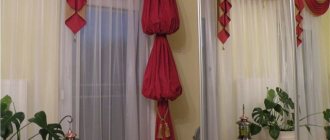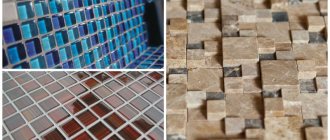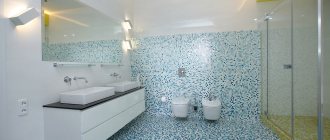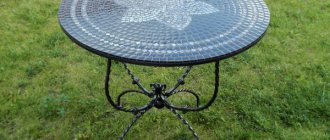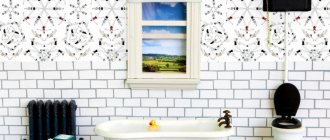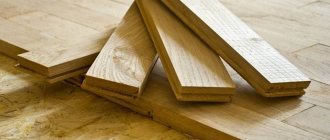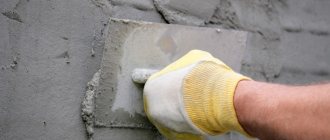Wooden mosaic for walls
This type of finishing consists of pieces of wood of various sizes and shapes. Advantages of mosaic:
- combines with other types of finishes;
- keeps warm;
- creates a feeling of comfort;
- will last a long time;
- environmentally friendly material;
- masks uneven walls;
- helps with zoning space;
- original drawing.
Flaws:
- some types of wood are not resistant to moisture;
- such finishing is not cheap;
- requires painstaking work.
Varieties
Today, many manufacturers offer interesting and beautiful wood mosaics. It is presented in several types: marquetry, intarsia, instruction and block. Each of these technologies is carried out using veneer. In one case it is simple; in other production methods, figured ones are used.
When working with simple veneer, it is easy to choose the direction of the fibers and color , because when laying it, the same direction of the wood fibers is used. If you use figured veneer, you must adhere to the pattern made on the surface of the mosaic elements. To create an original interior, you can use veneer in different colors. When laying it, you should adhere to a specific geometric composition (this way the design will be spectacular).
Where is it used?
It is used not only to decorate houses, but also cafes, restaurants and theaters, because this decoration creates a unique atmosphere in the room. It is suitable for rooms decorated in classic, modern or retro style. Suitable for country, Provence, Baroque. Looks great if the interior contains glass or metal parts. It is best to use it in large rooms. With the help of such finishing, you can highlight any part of the room, for example, a dining area, a fireplace, a relaxation area.
Wood mosaic in 3D technology
A modern apartment often presents interesting design projects. How to create an emphasis on individual areas of the room? An expressive material can help - wooden mosaic for walls in 3D technology. A three-dimensional surface can be created using different techniques: processing parts with different coloring compounds, firing individual parts or painting them with dull paints. Inserts from other materials will also help.
Currently, artificially aged volumetric mosaics are gaining popularity. There may be traces of woodworms, nails, scratches, traces of old paint, and so on. These tiles are actively used to create atmospheric interiors that imitate old wooden walls.
Wooden mosaic in the interior is a harmonious combination of style and taste, history and modernity. Wood is one of the most popular materials in the decoration of houses and apartments to this day. Its only drawback is the high price, but it also pays off with the long service life of the mosaic.
Kinds
Depending on the installation technique, as well as the size of the planned installation, you can choose a separate mosaic option.
- Intarsia
It represents images and patterns created from wooden plates of various species and colors (mostly uses no more than 4 tones). The prepared and polished plates are glued together and then attached to the base with glue, where a recess has been made in advance. To change the color of wood, special oils or boiling are sometimes used.
- Inlay
With this method, plates of other materials, such as ivory, are cut into a wood base. Moreover, the plates must be at the same level as the base. Expensive materials are usually used as inserts, making the finished mosaic striking in its luxury.
- Marquetry
Thin wooden plates - veneer - of various colors and types are glued onto the base, which can be made of wood. When creating paintings, the direction of the fibers is also taken into account.
- Block mosaic
This technique involves gluing bars of different colors or cross-sections, and then cutting them crosswise. Thus, bars with the same pattern are obtained, from which a mosaic is then created. They can be glued to the base or inserted into a prepared recess.
Advantages and disadvantages
Positive traits:
- the absence of toxic substances in the composition, which eliminates the possibility of the release of hazardous compounds when temperature and air humidity change; mosaic is an environmentally friendly product;
- long period of operation, it is important to adhere to the installation technique, which will protect the coating from moisture;
- unlike other materials, natural wood is characterized by low thermal conductivity, which makes it more preferable when choosing cladding for various surfaces on an object, since products of this type help reduce heat;
- combined with other types of cladding: tiles, metal, glass;
- it is possible to repair the coating, since products made of veneer and wood are much easier to dismantle compared to their ceramic counterpart;
- the mosaic substrate is characterized by moderate flexibility, which makes this type of material a preferable option for decorating surfaces that have minor defects; if desired, you can create a coating with asymmetrical elements, thanks to this it becomes possible to mask more significant irregularities;
- Wood cladding delays sound waves, which means that this material can be used as an auxiliary measure for finishing objects where sound insulation is planned.
The material also has disadvantages. Thus, they note the low resistance of some wood species to the influence of water. This means that you should be selective in your choice, without considering options with a high ability to absorb moisture. Another disadvantage is the need for regular maintenance. From time to time it is recommended to remove the old coating and re-varnish.
DIY wooden mosaic for walls: manufacturing process
Work on finishing the surface of a room with wooden mosaic slabs or small cubes:
- The size of the area that will be decorated with mosaics is measured.
- Then it is divided into small parts that need to be manufactured.
- After this, the parts are drawn on the wood and cut with a saw.
- The edges of the cut parts are formed using a milling machine.
The finished parts are treated with an antiseptic, then dried and polished, using first larger and then finer abrasives.
What is it?
Wood is an affordable natural material that is widely used in room design. Wooden mosaics can beautifully decorate your home. You can choose any shade you like, and today there are many of them on the finishing materials market. Each tone has a characteristic texture and a certain pattern. There are even varieties of wooden mosaics that combine 2 or even 3 shades. This decorative element is made from small pieces of wood or veneer of compact sizes (1 - 8.6 cm). Wooden elements are attached to the base in the form of a grid. To fix the pieces of wood, a certain adhesive composition is used. Mosaics are also made from wood shavings, which are mixed with water and cement.
Decorating walls with wooden mosaics: a guide
First you need to clean and level the walls (for faster leveling it is recommended to use plywood or drywall).
Then a primer is applied, which makes the walls absorbent. Mosaics need to be glued with compounds that do not contain water. Therefore, you need to use parquet glue rather than tile adhesive.
When filling joints, do not use grout that is used for ceramic tiles. Due to changes in humidity and temperature, the wood can change size, as a result of which the grout may simply crack. Therefore, special epoxy grouts are used.
Installation features
Mosaics can be used to decorate almost any surface, but they need to be prepared before installation. To do this, serious unevenness is eliminated using putty, after which a primer is applied to the wall. There is no need to lay out individual mosaic fragments into the ornament yourself; the products are produced in the form of modules. They are fixed to the surface using waterless adhesives, for example, parquet glue.
The laying technique is simple; the modular slabs are lightweight, which facilitates their quick gluing. In addition, there is no heavy load on the walls. During installation, all attention is paid to the evenness of the joints horizontally and diagonally. The fastening of each module is checked with measuring instruments.
The work is completed by filling the joints with two-component epoxy grout. You should not use mineral grout for these purposes; it will cause the wood to crack when the humidity level in the room changes.
Tips and tricks
To increase the service life, the finished mosaic is coated with wax or special oils.
Mosaic does not require special care. Simply wipe it with a damp cloth and then dry it.
Mosaic can also be used to decorate a kitchen backsplash or bathroom walls, but only after treating it with varnish.
To create a more interesting coating, use three-dimensional parts or combine parts of different shapes, for example, circles and rectangles. This design is suitable for spacious rooms, as it takes up a lot of space.
Considering all the advantages of mosaic, the ease of self-installation and the way it transforms the interior, we can call it an excellent material. With it you can easily make the room unique and cozy.
Features of using mosaics in different rooms
Decorating walls with mosaics allows you not only to brightly decorate a room and give originality to the design, but also to create a durable protective cladding coating.
Traditional mosaic does not lose its attractive appearance for many years, so the elements must be strong and durable. Fabric, straw, and beads are not used to create mosaics. The properties of the material used must correspond to the purpose of the room. Mosaic tiles in the bathroom create an attractive appearance for the room and ensure its cleanliness. Example options for using cladding:
- The screen under the bathtub can be decorated with plain or patterned mosaics.
- Using multi-colored wall coverings, you can highlight the area of the shower, bathtub, washbasin, etc.
- The wall next to the bathtub or washbasin with a mosaic apron looks great.
- The decoration of the bathroom will be a mosaic frame for the mirror.
- The coating can replace tiles for finishing niches and shelves.
- The window will appear visually larger if you trim the rim with a mosaic coating.
- If the room is small, you should not completely decorate it with mosaics. In this case, it is recommended to create panels or combine mosaics with another type of coating.
- In a small bathroom, it is recommended to use small decorative and floral designs.
In the living room, a good solution would be to place a mosaic panel above the sofa or fireplace.
It will emphasize the hospitality of the owners. A panel in the form of a luxurious carpet creates an atmosphere of harmony and beauty. For those wishing to cover an entire wall in the living room, it is recommended to use elements that create a shimmering effect. Guests will be surprised by the pleasant pearly shine of the coating. In the hallway, a plot panel on the wall or a mirror with mosaic cladding looks good. To create an atmosphere of unusualness, collect small mosaic drawings on the wall. You can decorate window sills, columns and niches with glass mosaics
In the kitchen, wall cladding with mosaics is popular due to modern materials that are easily cleaned of any dirt and are not afraid of high temperatures. The coating is used to create kitchen aprons near the sink. You can also highlight functional areas in the kitchen. Small bright drawings are often posted on the walls.
Finish options
The classic solution for using wood mosaics is to decorate walls. It can be used to decorate one wall, thereby zoning the room. You can use it to highlight a sleeping area, smooth transition from one to another room, and design a place to relax.
The mosaic looks impressive in spacious rooms when it is used to decorate a huge canvas. In this case, you can examine the texture of the wood and see the play of shades. Wooden mosaics are used to create floor coverings. It looks impressive and original. It can be used to decorate staircase steps and furniture. It looks attractive on the table.
Wooden mosaic is treated with special compounds to give it strength and reliability. The ideal solution would be a mosaic treated with an oil-wax composition. It can be used to decorate a bathroom or kitchen.
For example, you can:
- lay tiles around the bathtub or shower stall on the walls and floor;
- use a combination of mosaics in tandem with ceramic tiles, which will allow you to create original decor at minimal cost;
- decorate one wall with an unusual ornament or pattern from a wooden mosaic (a panel of different colors, a geometric pattern or an attractive landscape);
The built-in shelves, lined with mosaics and additionally decorated with lighting, look original. A bathtub lined with mosaic tiles on the outside looks impressive. You can decorate the mirror or washbasin area with an interesting accent.
Color solutions
Wooden mosaic surprises with its variety of natural shades. Its color depends on the type of wood used. Exotic trees look attractive and unusual. Wood mosaics are usually made in shades of brown. For example, ash is used for lighter tones, oak for darker shades, although today one of the most popular tones is the bleached tone of light wenge oak.
The mosaic surface may include elements of one or more tones. Light compositions are ideal for small rooms as they allow you to visually enlarge the space. Dark panels will help create a bright accent in the interior of a spacious room. Compositions that include light and dark elements and a variety of textures look impressive and original. This composition will become an interior decoration.
How to prepare the base for laying mosaics?
There are two types of mosaics:
- Ready-made tiles glued to a mesh or paper base. They are convenient to use when you need to create a continuous mosaic canvas with an unobtrusive pattern. The mesh can be cut, giving the fragments the desired shape.
- Fragments that are made by hand. At the same time, the master adjusts individual fragments to their shape, creating his masterpiece. For this finishing, broken tiles or natural (artificial) stone are used.
Whatever type of mosaic is chosen, the surface must be carefully prepared. The plane on which the finishing material will be applied must be flat. Even if there are radii and curvatures, you need to thoroughly clean the surface so that there are no bumps. Unless they were not provided for initially. Because during installation, not every wall defect can be corrected with an adhesive solution. And shortcomings in the preparatory work can affect the outcome of the entire case. Therefore, the surface must be carefully plastered and sanded. If possible, you can line the walls with plasterboard.
Related article: Adhesive for extruded polystyrene foam to concrete
Naturally, the base must be cleaned of previous coatings. Residues of paint, foreign objects and other contaminants must be removed. Dust must be removed and the surface primed. Otherwise, after a couple of years, the tiles may fall off and the beauty will be ruined.


